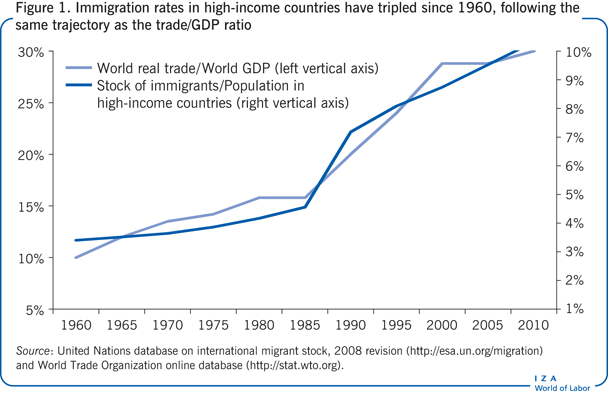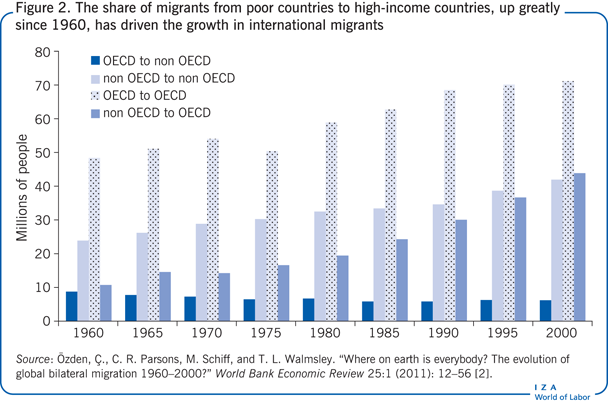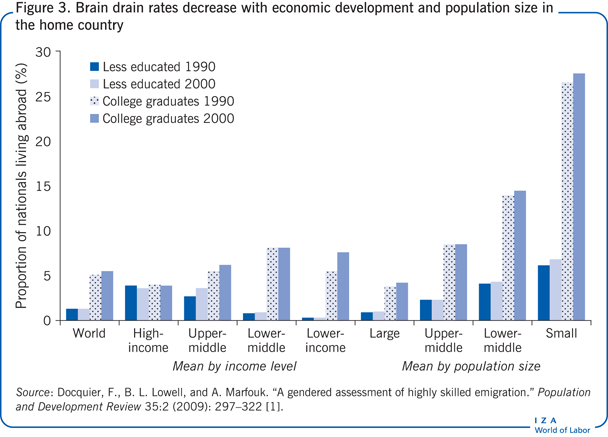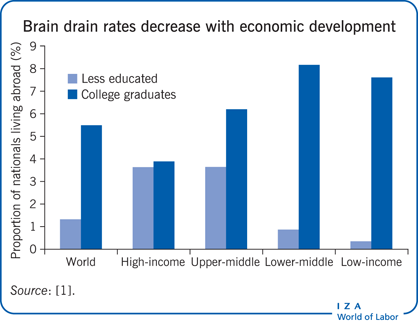Elevator pitch
The proportion of foreign-born people in rich countries has tripled since 1960, and the emigration of high-skilled people from poor countries has accelerated. Many countries intensify their efforts to attract and retain foreign students, which increases the risk of brain drain in the sending countries. In poor countries, this transfer can change the skill structure of the labor force, cause labor shortages, and affect fiscal policy, but it can also generate remittances and other benefits from expatriates and returnees. Overall, it can be a boon or a curse for developing countries, depending on the country’s characteristics and policy objectives.
Key findings
Pros
The income-maximizing level of a brain drain is usually positive in developing countries, meaning that some emigration of the more skilled is beneficial.
A brain drain stimulates education, induces remittance flows, reduces international transaction costs, and generates benefits in source countries from both returnees and the diaspora abroad.
Appropriate policy adjustments, which depend on the characteristics and policy objectives of the source country, can help to maximize the gains or minimize the costs of the brain drain.
Cons
The effective brain drain exceeds the income-maximizing level in the vast majority of developing countries, especially in sub-Saharan Africa, Central America, and small countries.
A brain drain may cause fiscal losses.
Above a certain level, brain drain reduces the stock of human capital and induces occupational distortions.
Author's main message
The impact of the brain drain on a source country’s welfare and development can be beneficial or harmful. The evidence suggests that there are many more losers than winners among developing countries. Whether a country gains or loses depends on country-specific factors, such as the level and composition of migration, the country’s level of development, and such characteristics as population size, language, and geographic location. Policymakers should gauge the costs and benefits of the brain drain in order to design appropriate policy responses.
Motivation
The term “brain drain” refers to the international transfer of human capital resources, and it applies mainly to the migration of highly educated individuals from developing to developed countries. In lay usage, the term is generally used in a narrower sense and relates more specifically to the migration of engineers, physicians, scientists, and other very high-skilled professionals with university training, often between developed countries.
Although a concern for rich countries, the brain drain has long been viewed as a serious constraint on the development of poor countries. Comparative data reveal that by 2000 there were 20 million high-skilled immigrants (foreign-born workers with higher education) living in member countries of the Organisation for Economic Co-operation and Development (OECD), a 70% increase in ten years. Two-thirds of these high-skilled immigrants came from developing and transition countries.
Discussion of pros and cons
Key trends in high-skilled migration
According to the United Nations Global Migration Database, the number of international migrants increased from 75 million in 1960 to 214 million in 2010. This about parallels the growth in the world population, so the world migration rate increased only slightly in relative terms, from 2.5% to 3.1% of the world population. The major part of this change is artificial and due to the break-up of the former Soviet Union, when what was once the internal movement of workers became reclassified as international migration after 1990. Overall, the share of international migrants in the world population has been stable for the last 50 years.
But the picture changes when the focus is narrowed to migration to developed countries. The proportion of international migrants residing in high-income countries relative to the total in all possible destinations increased from 43% to 60% between 1960 and 2010. As measured by the proportion of the foreign-born in the total population of high-income countries, the average immigration rate to these countries has tripled since 1960 and doubled since 1985. The increase has followed the same trajectory as the ratio of trade to gross domestic product (GDP) (see Figure 1).

More of these migrants are coming from non-OECD countries. Indeed, a database of global bilateral migration published in 2011 reveals that as of 2000, migration between developing countries still dominated the global migrant stock: at 72.6 million people, migration between developing countries constituted about 45% of all international migration (see Figure 2) [2]. Next came migration from developing to developed countries (55 million, 34% of all migrants) and then migration between developed countries (28 million, 17%). But the growth in the number of migrants was driven largely by emigration from developing countries to developed countries, which increased from ten million to 55 million between 1960 and 2000, faster than trade.

Emigration rates of high-skilled workers exceed those of low-skill workers in virtually all countries (see Figure 3) [1]. The skill bias in emigration rates is particularly pronounced in low-income countries (see What drives the brain drain, and how can we quantify it?). The largest brain drain rates are observed in small, poor countries in the tropics, and they rise over the 1990s. The worst-affected countries see more than 80% of their “brains” emigrating abroad, such as for Haiti, Jamaica, and several small states with fewer than one million workers. About 20 other countries are losing between one-third and one-half of their college graduates. Most are in sub-Saharan Africa (such as Liberia, Sierra Leone, and Somalia) or Asia (such as Afghanistan and Cambodia). A few are small, high-income countries (such as Hong Kong and Ireland).

Expected adverse and beneficial effects of skilled migration
The brain drain has long been viewed as detrimental to the growth potential of the home country and the welfare of those left behind. It is usually expected to be even more harmful for the least developed countries because, as explained above, with increasing development, positive selection in emigration and brain drain rates fall.
A brain drain can also have benefits for home countries. Alongside positive feedback effects from remittances, circular migration, and the participation of high-skilled migrants in business networks, innovation, and transfers of technology, consider the effect of migration prospects on the formation of human capital in home countries. New research suggests that limited high-skilled emigration can be beneficial for growth and development, especially for a limited number of large, middle-income developing countries. But for the vast majority of poor and small developing countries, skilled emigration rates significantly exceed the optimal rate (see Terms used in migration studies).
The broad diversity of brain drain effects on development has been illustrated in case studies. The contribution of expatriate Indian engineers and information technology professionals to the Indian growth miracle has been recognized. But the medical brain drain from sub-Saharan Africa has been detrimental. A brain drain can also generate both beneficial and adverse effects for long-term development—as with the emigration of Filipino nurses to the US or Egyptian teachers to Arab states in the Persian Gulf.
Adverse effects
The social returns to human capital are likely to exceed its private returns given the many externalities, both technological and sociological (see Terms used in migration studies). This externality argument has been central in the literature since the 1970s, and the seminal contribution on this subject concludes that the brain drain entails significant losses for those left behind and increases global inequality [3].
Another cost is that high-skilled emigrants do not pay taxes in their home country once they have left. As education is partly or totally subsidized by the government, emigrants leave before they can repay their debt to society. This fiscal cost may be reinforced by governments distorting the provision of public education away from general (portable) skills when graduates leave, with the country perhaps ending up educating too many lawyers and too few nurses, doctors, or engineers.
A third negative effect is inducing shortages of manpower in key activities, as when engineers or health professionals emigrate in disproportionately large numbers, undermining a country’s ability to adopt new technologies or deal with health crises.
Fourth, the brain drain increases the technological gap between leading and developing nations because the concentration of human capital in the most advanced economies contributes to their technological progress.
Ambiguous effect on the educational and occupational structure of the labor force
The argument can, however, be reversed because uncertainty about the prospects for migration may create a bias in the opposite direction. When education is seen as a passport to emigration, this creates additional incentives to undertake further education. But if young people are uncertain about their chances of future migration when they make education decisions, this can be turned into a gain for the home country under certain circumstances [4], [5].
Case studies on the “brain gain” hypothesis
In Tonga and Papua New Guinea, nearly all (85%) of the very top high school students contemplate emigration while still in high school; this leads them to take additional classes and make changes to their course choices in favor of fields such as science and commerce [6]. In Cape Verde, emigration prospects are among the main drivers of human capital formation [7]. In Fiji, the educational attainment of ethnic Fijians has been compared with that of Fijians of Indian ancestry in the aftermath of the 1987 military coup, which resulted in physical violence and discriminatory policies against the Indian minority [8]. For the latter, the correlation was strong between changes in emigration prospects and human capital investments.
Other studies have not found evidence of a brain gain. This is so for the brain drain of physicians from sub-Saharan Africa, where limited training capacities prevent students from responding to incentives, or migration from Mexico to the US, where there is a bias toward low-skill workers in emigration prospects.
From a development perspective, however, what matters is not how many of a country’s native-born engage in higher education, but how many of those who do engage remain at home. The brain drain can benefit a home country if it increases the proportion of college graduates in the population remaining. There are two conditions for such a benefit to obtain. First, the level of development in the country should be low enough to generate strong incentives for the more educated to emigrate, but not so low that personal liquidity constraints on investment in education become strongly limiting (in which case the incentive cannot operate). Second, the probability of emigration by high-skilled workers must be sufficiently low—for example, below 15–20%. On average, the level of brain drain that maximizes human capital accumulation in a developing country is around 10%. This level varies across countries, depending on their size, location, language, and public policies. In particular, it declines with development and the effectiveness of the higher education system.
The hypothetical levels of human capital that would be obtained in the absence of brain drain have been simulated and compared with actual levels [5]. Countries with low human capital and low emigration rates are likely to experience a net gain. But there appear to be many more losers than winners (88 losers and 20 winners out of 108 developing countries). Importantly, the losers show substantial losses, and the winners only small gains. The situation of many sub-Saharan African, Central American, and small developing states appears worrisome in this respect. In contrast, the largest developing countries (Brazil, China, India) all seem to experience moderate gains.
Other beneficial feedbacks
The global impact of brain drain on development and the income of those left behind depends on other beneficial feedbacks operating after migration. The main ones are remittances, circular migration, and externalities from the presence of emigrants abroad (such as lower bilateral trade costs). The level of brain drain that maximizes income and development in the home country may then exceed 10% by a few percentage points, depending on the size of these feedbacks.
Remittances
Remittances by high-skilled migrants to family or relatives can replenish the stock of human capital that may have been depleted in the home country by the brain drain. The evidence is still unclear on the relative propensity of high-skilled and low-skilled migrants to remit. In 14 household surveys on immigrants in 11 destination countries, the relationship between education and the likelihood of remitting is mixed, but the relationship between education and the amount remitted is strong and positive [9].
Overall, high-skilled migrants remit more, but this result does not hold in all surveys, suggesting that the link between education and remittances is diverse and varies across host/home-country pairs. In the absence of surveys that match sending and receiving households, it remains difficult to quantify the effect of high-skilled migrant remittances on investment, poverty, or inequality in the home country. The economic consequences of remittances likely vary across home countries [9].
Circular migration
Return or circular (repeated return) migration is a promising route for allowing host and home countries to share the benefits of high-skilled labor mobility. In developing countries, the possibility of temporary emigration increases the returns to education and has the same effects on human capital formation as permanent, uncertain migration; returnees’ additional knowledge and financial capital acquired while abroad generates important benefits, especially for technology adoption, entrepreneurship, and productivity. Intentions to return are similar across skill groups, and return decisions depend on the economic and political situation in the home country.
Although return migration is probably the least documented aspect of international migration, it is commonly accepted that historical examples of massive return migration of high-skilled workers are more a consequence than a cause of development and sound policy reform in home countries.
Diaspora externalities
High-skilled migrants can reduce transaction costs between countries and thus facilitate trade, foreign direct investment, and technology transfers between host and home countries. There can also be diaspora externalities for institutional quality and for promoting democracy in the home country.
Is the brain drain a cause or consequence of poverty?
Brain drain and the economic development of home countries are two interdependent processes. First, a brain drain affects development, and its effect becomes unambiguously negative when the emigration rate is high. Second, a lack of economic growth motivates college graduates to emigrate. Interactions between these two variables can be the source of vicious and virtuous circles linked to individual decisions to migrate. Once a significant brain drain gets under way, it can have damaging effects on the economy that induce further waves of emigration by high-skilled workers (Iran after the 1978–1979 revolution, the Irish crisis of the early 1980s, the ex-USSR republics after 1991). But when a return is significant, it gives incentives to other waves of returnees to come home (Ireland after the fiscal reform of 1987, Taiwan in the 1980s).
Human capital accumulation and development slow with the brain drain, the “skill-setting curve,” and the brain drain slows with development, the “migration-setting curve” [10]. An intersection between these two downward-sloping curves represents an equilibrium. The system may generate multiple equilibria: countries that share similar characteristics may end up in a favorable equilibrium with low poverty and a low brain drain, or an unfavorable one with high poverty and a high brain drain.
In the majority of developing countries, the favorable equilibrium prevails, and the observed level of brain drain should be seen as an inevitable by-product of poverty. But in about 50% of small developing countries—those with fewer than one million working-age adults—the unfavorable equilibrium prevails, implying that poverty and brain drain could be reduced if individual emigration decisions were coordinated. This is the case with small countries such as Cape Verde, Grenada, Guyana, Haiti, Jamaica, Mauritius, Saint Vincent and the Grenadines, and Suriname.
In badly coordinated countries, a move to the favorable equilibrium could increase wages and GDP per capita by more than 100%. If a mass brain drain is fairly recent in the country and a good equilibrium is stable, the likelihood of a coordination failure depends on how people deviate from the preceding good equilibrium in response to adverse shocks in the recent past. Small states are much more likely to be badly coordinated because migration from such states is more responsive to economic shocks. These small countries require appropriate development policies, such as temporary subsidies for the repatriation of high-skilled expatriates.
Limitations and gaps
Due to data constraints, identifying the impact of the brain drain on welfare and development in originating countries is complex. Determining the size of the effects and whether they are positive or negative remains controversial among economists. A first priority is to improve the data on international migration along several dimensions, particularly its frequency, the quality of education, and the levels of education in different disciplines. Second, the state of comparative data on immigration laws and policies, especially their bilateral dimension (between home and host countries), is another limiting factor on cross-country studies of the determinants of migration flows and for analysis of the effects of policy reforms.
With few exceptions, micro-studies of migration and development have not yet taken full advantage of the randomization revolution in statistics. A third task, then, is to design and exploit the bilateral dimensions of future migration data sets for cross-country analysis and, at a micro level, to investigate natural events and policy experiments to identify the causal effects of high-skilled migration on development outcomes.
Summary and policy advice
For many developing countries the income-maximizing or “optimal” emigration rate of highly educated workers is positive (at about 10% of the total). Imposing too many restrictions on the international mobility of educated residents could be detrimental for development, although the brain drain exceeds its optimal level in most poor countries. So, for starters, policymakers should determine the level and composition of migration from their country—and whether migration is on balance harmful or beneficial.
The conditions under which a country gains or loses are not beyond its control. To a large extent, they depend on the policies it adopts (education policy, quality of institutions) and those in force in the main host countries. The appropriateness of adjustments of local policies and supranational interventions (such as taxing emigrants, subsidizing repatriation, providing compensatory development assistance) vary with such country characteristics as population size, location, and language (see Appropriate policy responses to the brain drain are country-specific). Policymakers should gauge the costs and benefits of the brain drain in order to design appropriate policy responses.
Acknowledgments
The author thanks two anonymous referees and the IZA World of Labor editors for many helpful suggestions on earlier drafts. This article is based on previous work [10], [11], [12].
Competing interests
The IZA World of Labor project is committed to the IZA Guiding Principles of Research Integrity. The author declares to have observed these principles.
© Frédéric Docquier
What drives the brain drain, and how can we quantify it?
Terms used in migration studies
Externality: An individual’s costs and benefits can result from the activities or transactions of others. For example, emigration of community members reduces the moving costs of other members of the same community and reduces other transaction costs between countries (such as trade costs). The latter effects are referred to as diaspora externalities.
Optimal emigration rate: The level of skilled/educated emigration that maximizes human capital accumulation in a developing country.
Private and social returns on human capital: The private return to education is the impact of the individual’s education level on her/his income or employment. The social return is the additional impact that an individual’s education has on the other members of the society.
Appropriate policy responses to the brain drain are country-specific
Should home countries rethink their education policies in the face of the brain drain? Home-country governments could respond to the departure of the highly educated by reducing the public supply of higher education. Other possible routes include promoting the education of graduates abroad or adjusting the quality of local education.
Are the immigration policies of host countries at odds with their aid and development policies? Selective immigration policies aimed at highly educated and skilled workers may or may not contradict the objectives of developed countries’ aid and development programs.
Is a “tax on brains” required for a better sharing of the global surplus arising from international high-skilled migration? Taxing emigrants could help in compensating poor countries for the potential loss of human capital and in redistributing the financial benefits that accrue to skilled emigrants. But it would be inappropriate if the originating country actually benefits from the brain drain, if emigrants were unemployed or ineffectively employed at home, if they emigrated to escape corruption, violence, and economic discrimination, or if their education was privately financed and/or acquired abroad. Such a tax could also deter return migration and encourage emigrants to voluntarily forfeit their natural-born citizenship.
